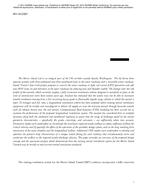Description
The Mercer Island Lid is an integral part of the I-90 corridor outside Seattle, Washington. The lid forms three separate tunnels with three eastbound and three westbound lanes in the outer roadways and a reversible center roadway. Sound Transit’s East Link project proposes to convert the center roadway to light rail transit (LRT) operations and add new HOV lanes in each direction in the outer roadways by reducing lane and shoulder widths. The changes alter the risk profile of the tunnels, which currently employ a fully transverse ventilation scheme designed to standards in place at the time of construction more than twenty years ago. Analysis has indicated that the system may not be able to maintain tenable conditions ensuing from a fire involving heavy goods or flammable liquids cargo vehicles to which the tunnel is open. To mitigate such fire risks, a longitudinal ventilation scheme has been proposed where existing tunnel ventilation equipment will be retrofit and reconfigured to deliver all supply air near the entrance portals through Saccardo nozzles with all exhaust drawn near the exit portals. Computational fluid dynamics (CFD) modeling has been carried out to evaluate the performance of the proposed longitudinal ventilation system. The analysis has considered fires at multiple locations along both the eastbound and westbound roadways to assure that the range of challenges posed by the tunnel geometric characteristics – specifically the grade, cross-slope, and curvature – are sufficiently taken into account. Parametric studies were undertaken to: (1) identify the minimum required nozzle airflows to induce sufficient airflows for critical velocity and (2) quantify the effects of the operation of the sprinkler deluge system, such as the drag resulting from interaction of the water droplets and the longitudinal airflow. Additional CFD studies were undertaken to develop and optimize the pressure drop characteristic of a unique nozzle fitting for each roadway that simultaneously turns and accelerates the airflow to the required nozzle discharge velocity. This paper provides an overview of the proposed design concept and the associated analysis which demonstrate how the existing tunnel ventilation system for the Mercer Island Tunnels may be retrofit to meet current tunnel ventilation standards.
Citation: ASHRAE Papers CD: 2014 ASHRAE Winter Conference, New York, NY
Product Details
- Published:
- 2014
- Number of Pages:
- 8
- File Size:
- 1 file , 2.1 MB
- Product Code(s):
- D-NY-14-C051




